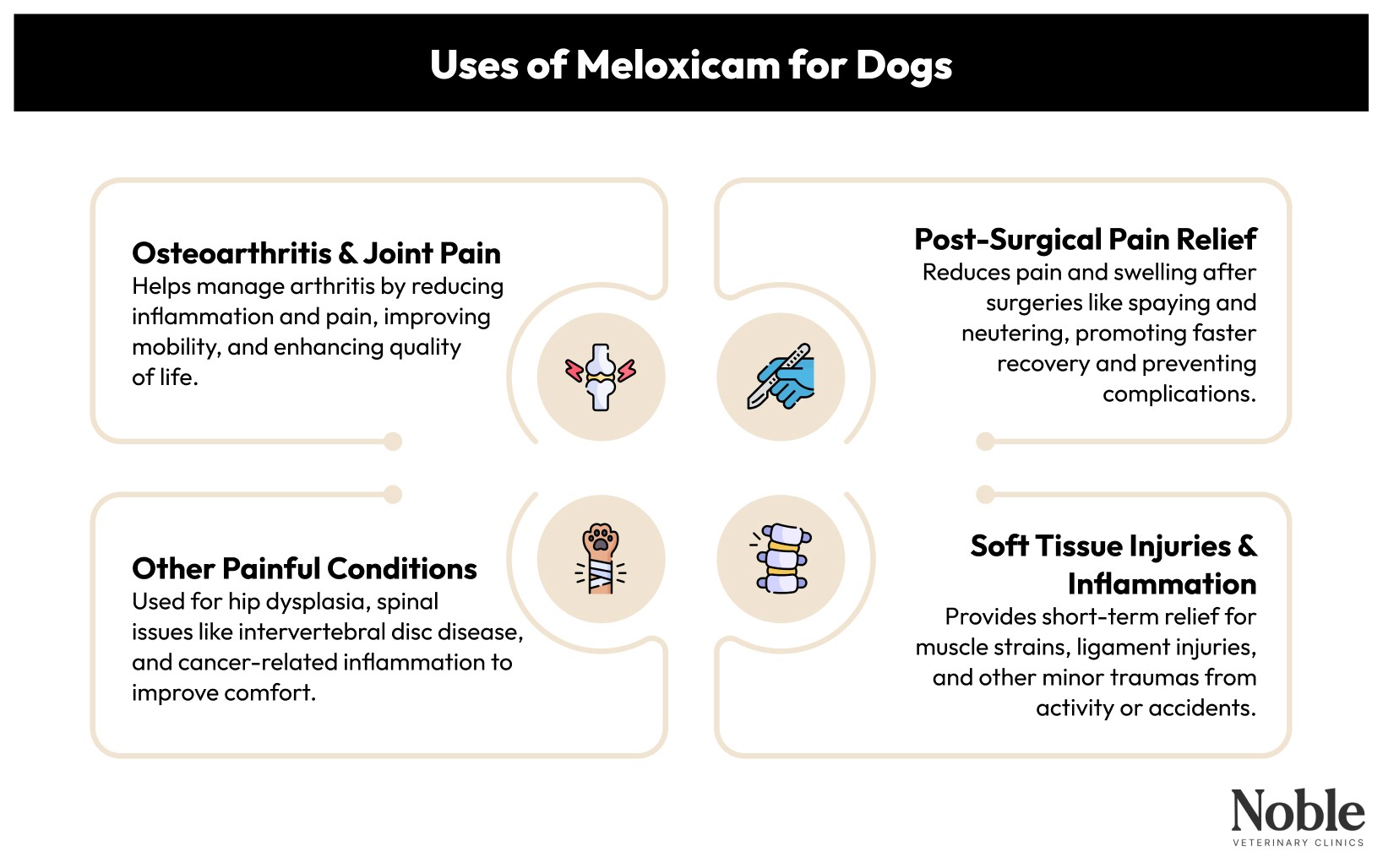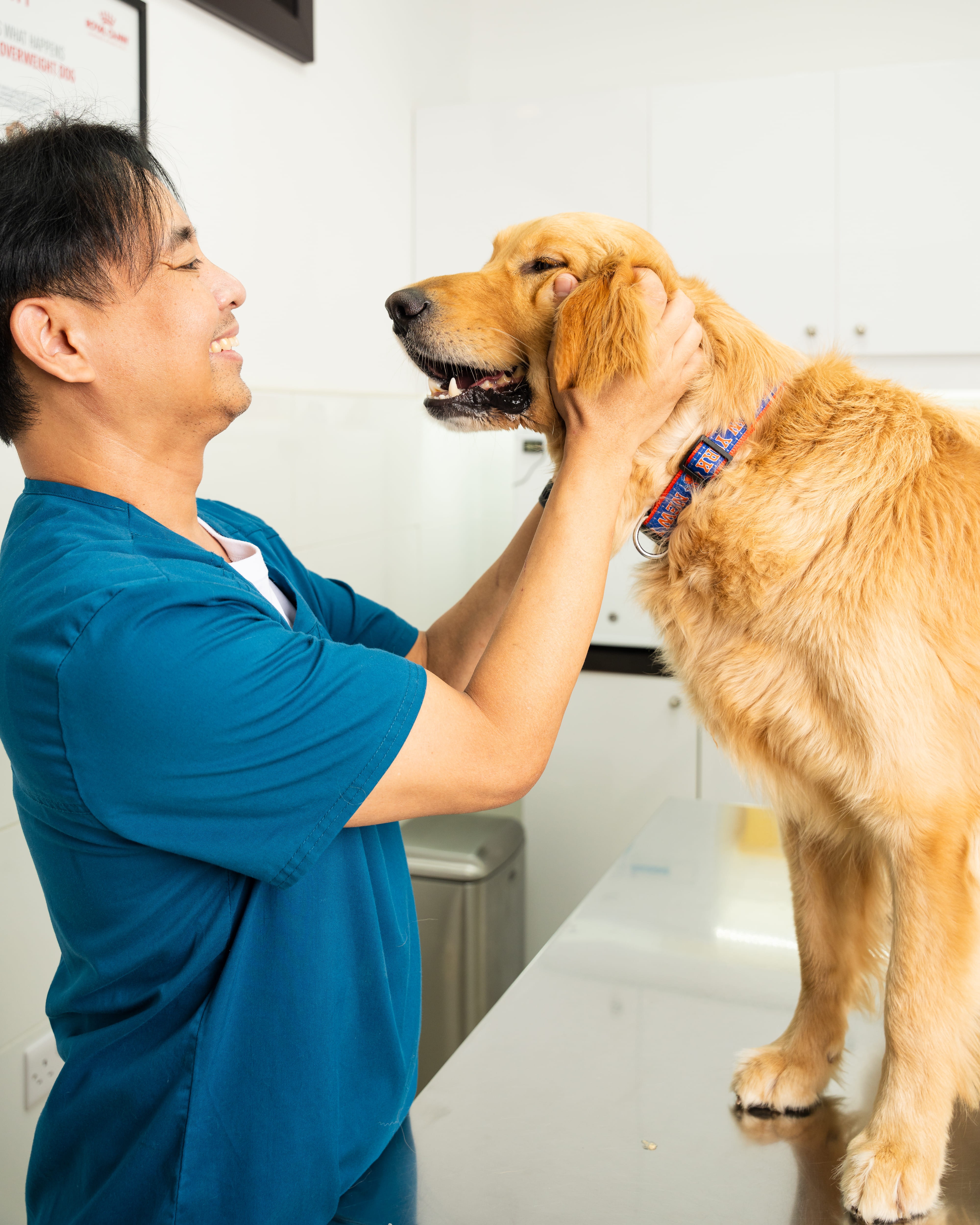February 18, 2025
If your dog is struggling with pain due to arthritis, an injury, or recovering from surgery, we may prescribe a couple of medications to help. One of these is meloxicam for dogs. Meloxicam is a popular non-steroidal anti-inflammatory drug (NSAID) that reduces pain, swelling, and stiffness in dogs.
It is commonly used in vet medicine to treat chronic joint pain in older dogs with arthritis, as well as pain from injuries or surgical procedures. By reducing inflammation, meloxicam helps dogs move more comfortably, improving their overall quality of life.
With that said, let’s talk about everything you need to know about Meloxicam for dogs.
How Does Meloxicam Work in Dogs?
Meloxicam essentially helps dogs who are experiencing pain and discomfort. The drug does this by inhibiting cyclooxygenase, specifically COX-2. By doing so, COX-2 is hindered from making prostaglandins, compounds that contribute to inflammation, pain, and fever.
Meloxicam is typically available in several forms, including a liquid form, chewable tablets, and injectable solutions. We often administer the first dose as an injection during a clinic visit, followed by continued oral treatment at home. The liquid formulation is particularly popular for dogs because it can be mixed with food to make administration easier.
While meloxicam in dogs can be highly effective in managing pain, it’s not a cure for health conditions like arthritis or injuries. It is a pain reliever and anti-inflammatory agent, meaning it helps improve a dog's mobility and comfort but does not reverse joint damage or heal injuries.
What are the Uses of Meloxicam for Dogs?
Meloxicam is primarily prescribed for dogs to manage pain and inflammation. Since inflammation is prevalent in many canine health problems, meloxicam can significantly improve a dog’s comfort and mobility when used correctly.
Here are the common uses of meloxicam for dogs:

Osteoarthritis and Joint Pain
One of the main reasons veterinarians prescribe meloxicam is to manage arthritis in dogs. Osteoarthritis is common in many large dogs, seniors, and those with a history of joint injuries. The condition causes chronic inflammation, leading to stiffness, pain, and reduced mobility.
By reducing inflammation and pain, meloxicam allows dogs with arthritis to move more comfortably, stay active, and maintain a better quality of life. While it does not cure arthritis, it helps slow down the progression of symptoms and makes daily activities much easier.
Post-Surgical Pain Management
Pain and inflammation are common side effects of surgeries. Routine procedures like spaying and neutering can make use of meloxicam for dogs to give them relief from the pain during recovery. Vets often prescribe meloxicam to help reduce post-surgical swelling and discomfort.
Post-surgical pain relief is essential for faster healing. When dogs are in pain, they may avoid movement, refuse to eat, or even lick or bite at their surgical wounds. By keeping their pain under control, meloxicam helps them recover more comfortably and prevents complications caused by excessive stress or pain.
Soft Tissue Injuries and Inflammation
Dogs are active animals, and accidents happen. Whether it’s a muscle strain, ligament injury, or minor trauma, inflammation is a natural response to injury. Meloxicam is often prescribed for short-term pain relief in dogs that have suffered soft tissue injuries from playing, running, or roughhousing.
In addition to injuries, meloxicam may be used for other inflammatory conditions affecting different parts of the body, such as swollen gums from dental disease or inflammation associated with infections. However, it is not an antibiotic and does not treat infections directly. The medicine only helps with the pain.
Other Health Conditions
While arthritis, surgery, and injuries are the most common reasons for prescribing meloxicam, veterinarians may also use it for other conditions that cause pain to dogs.
These include:
Hip Dysplasia. Common in large breeds, hip dysplasia can cause joint pain and inflammation.
Intervertebral Disc Disease. This is a spinal condition that causes nerve pain and mobility issues, often seen in Dachshunds and other long-backed breeds.
Cancer-Related Pain. Some types of cancer in dogs, such as bone cancer, cause significant inflammation.
What are the Side Effects of Meloxicam for Dogs?

While meloxicam is generally safe when used correctly, it can cause side effects. Some are mild, others more serious. Because it is an NSAID, its most common side effects involve the digestive system, kidneys, and liver.
Here are the common side effects of meloxicam for dogs:
Vomiting. Some dogs may vomit shortly after taking meloxicam, especially if it's given on an empty stomach.
Diarrhea. Soft or loose stools can occur as the digestive system adjusts to the medication. If diarrhea is persistent or severe, it could be a sign of a more serious reaction.
Loss of Appetite. Some dogs may eat less or show reduced interest in food. You might notice them not finishing their bowls or not rushing for their favorite treats.
Digestive Upset. Aside from diarrhea, some dogs may experience bloating, mild stomach discomfort, or flatulence.
Lethargy. Meloxicam can make some dogs feel tired or sluggish. This should improve as their body adjusts, but if lethargy is severe or prolonged, it may indicate an underlying issue.
Increased Thirst and Urination. Some dogs drink more water and urinate more frequently, which can indicate kidney stress. Therefore, it's important to monitor their water intake and bathroom habits.
In some cases, the side effects of meloxicam for dogs can be severe and can affect a specific part of their system. These include:
Gastrointestinal Bleeding or Ulcers. NSAIDs like meloxicam for dogs can cause stomach ulcers or intestinal bleeding, especially with long-term use. Signs include vomiting blood, black stools, and severe abdominal pain.
Kidney Damage or Failure. Since meloxicam is processed through the kidneys, excessive doses or long-term use can cause kidney problems. Watch out for increased thirst and urination, dehydration, weakness, loss of appetite, and weight loss.
Liver Damage. The liver is responsible for metabolizing meloxicam, and in rare cases, it can become overloaded, leading to liver failure. Symptoms include jaundice, loss of appetite, extreme lethargy, and weight loss.
When is Meloxicam Bad for Dogs?
While meloxicam is a widely used and effective medication for dealing with pain in dogs, it is not suitable for every pup. Certain health conditions, drug interactions, and improper use can be dangerous, so it’s important to take note of these.
Meloxicam is bad for dogs with these health conditions:
Kidney Disease. Since meloxicam is processed through the kidneys, dogs with existing kidney issues are at a higher risk of kidney failure.
Liver Disease. The liver is responsible for metabolizing meloxicam, so dogs with liver disease may struggle to break it down, leading to toxicity.
Gastrointestinal Problems. NSAIDs can cause or worsen ulcers, making them dangerous for dogs with a history of stomach ulcers, internal bleeding, or clotting disorders.
Severe Dehydration or Low Blood Pressure. Dehydrated dogs or those with circulation issues are more vulnerable to kidney damage from NSAIDs.
Pregnant or Nursing Dogs. Meloxicam may harm unborn puppies or be passed through breast milk to nursing puppies.
Puppies Under 6 Months Old. Young puppies have underdeveloped kidneys and livers, making them more susceptible to toxicity.
Aside from medical problems,
Other NSAIDs. Meloxicam should not be used with other types of NSAIDs.
Corticosteroids. Medications like prednisone can severely increase the risk of stomach ulcers when combined with meloxicam.
Diuretics. Generally, these are used for heart disease or high blood pressure. Diuretics increase urine output, which can stress the kidneys when combined with NSAIDs.
Blood Thinners. Anticoagulants can increase the risk of bleeding problems when used with NSAIDs.
How to Use Meloxicam for Dogs?

Meloxicam can be a highly effective pain reliever for dogs when used correctly, but improper use can bring serious health issues.
To help your dog stay safe while taking meloxicam, here’s a few tips:
Always Follow the Prescription
Meloxicam is a prescription medication, meaning it should only be given under veterinary supervision. We’ll inform you of the correct dosage based on your dog’s weight, medical history, and specific condition. Never adjust the dose on your own or extend the duration of treatment.Administer Meloxicam With Food
NSAIDs like meloxicam can irritate the stomach lining, increasing the risk of nausea, vomiting, and ulcers. To reduce this risk, mix the medication with your dog’s food. Meloxicam should not be taken on an empty stomach. Additionally, give your dog plenty of water in the process.
Do Not Combine With Other Medicines
Combining meloxicam with other NSAIDs or steroids significantly increases the risk of gastrointestinal bleeding, kidney damage, and ulcers. Always tell us about any other medications your dog is taking.Watch for Side Effects
Even when used correctly, some dogs may experience mild to severe side effects. Keep an eye out for your dog’s condition during the entire treatment process. If any side effects appear, stop the treatment and inform us immediately.Regular Vet Checkups
If your dog needs meloxicam for chronic pain management, regular veterinary checkups are essential. Long-term NSAID use can affect kidney and liver function, so we’ll keep an eye on these specifically.
Store Meloxicam Safely
Always store meloxicam in a safe place, away from pets and children. Accidental overdoses can be dangerous and require immediate veterinary care.
Keeping our dogs healthy and pain-free is one of the joys of life. It’s about giving them the best quality of life, full of energy, comfort, and joy.
- Dr. Lidija Krvavac
Conclusion
Meloxicam can be a highly effective pain medication for dogs suffering from conditions like arthritis, injuries, and post-surgical discomfort. However, like any medication, meloxicam for dogs must be used with caution and under veterinary supervision.
By following the prescription, administering the medication with food, and closely monitoring your dog for side effects, meloxicam can help your dog live a pain-free life.
Subscribe to Our
Newsletter
Sign up for weekly pet health tips and insights from our veterinarians.



